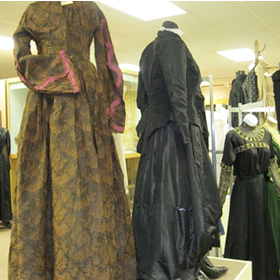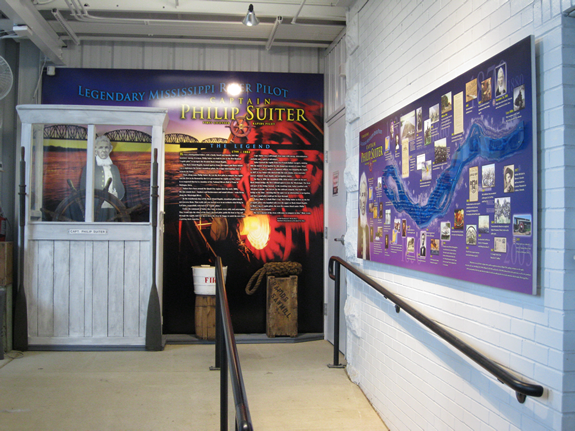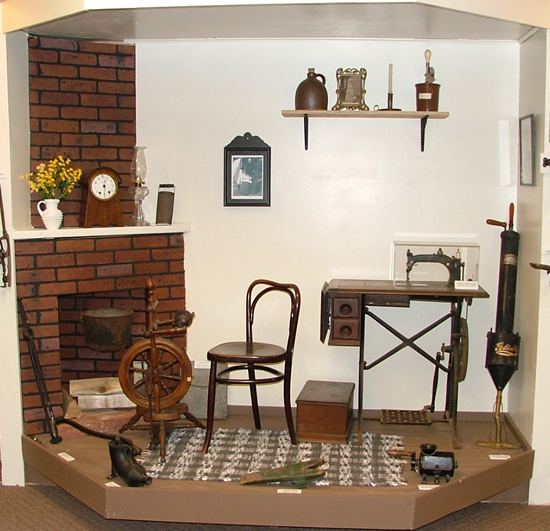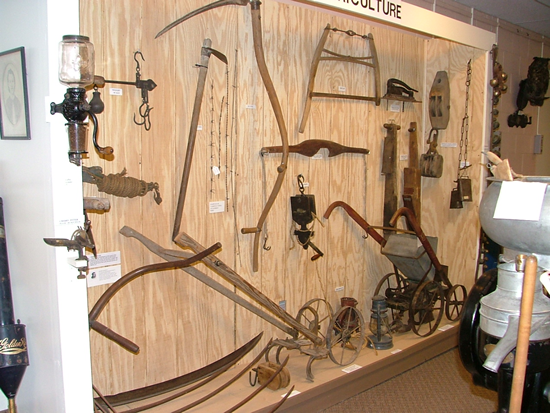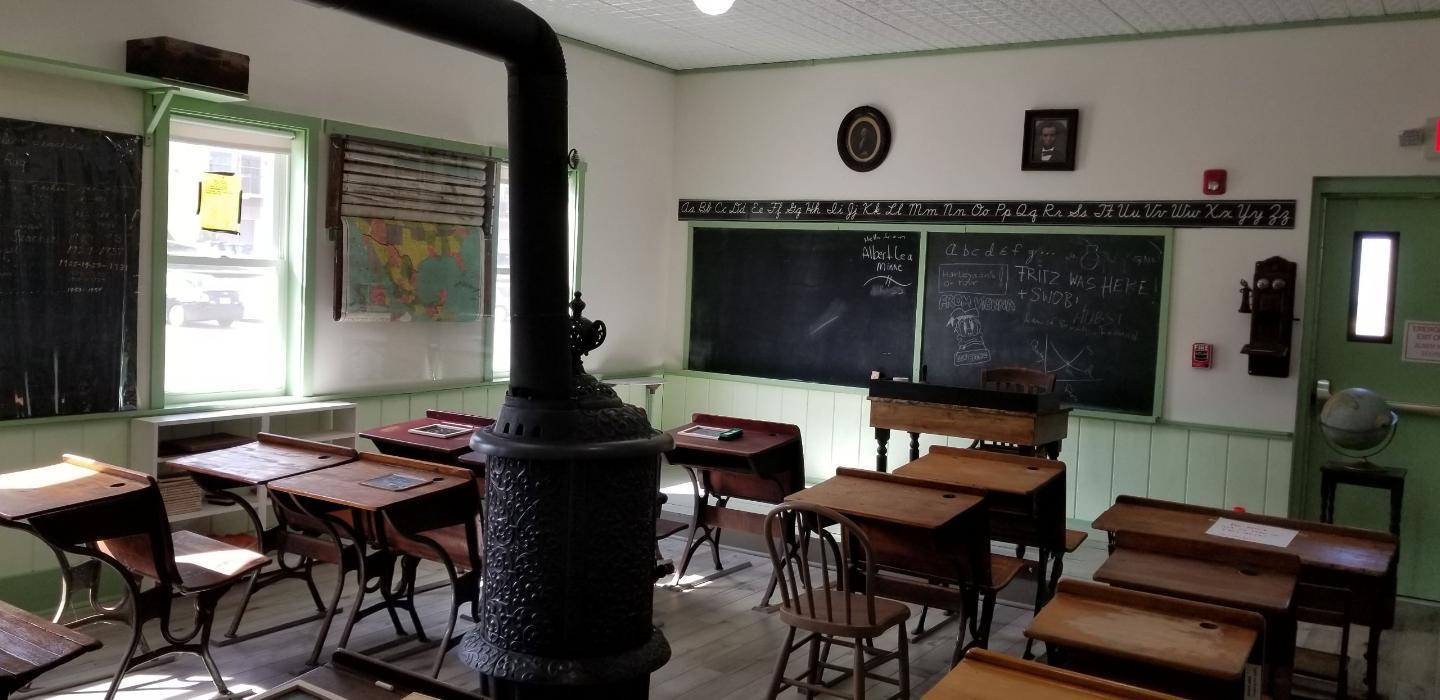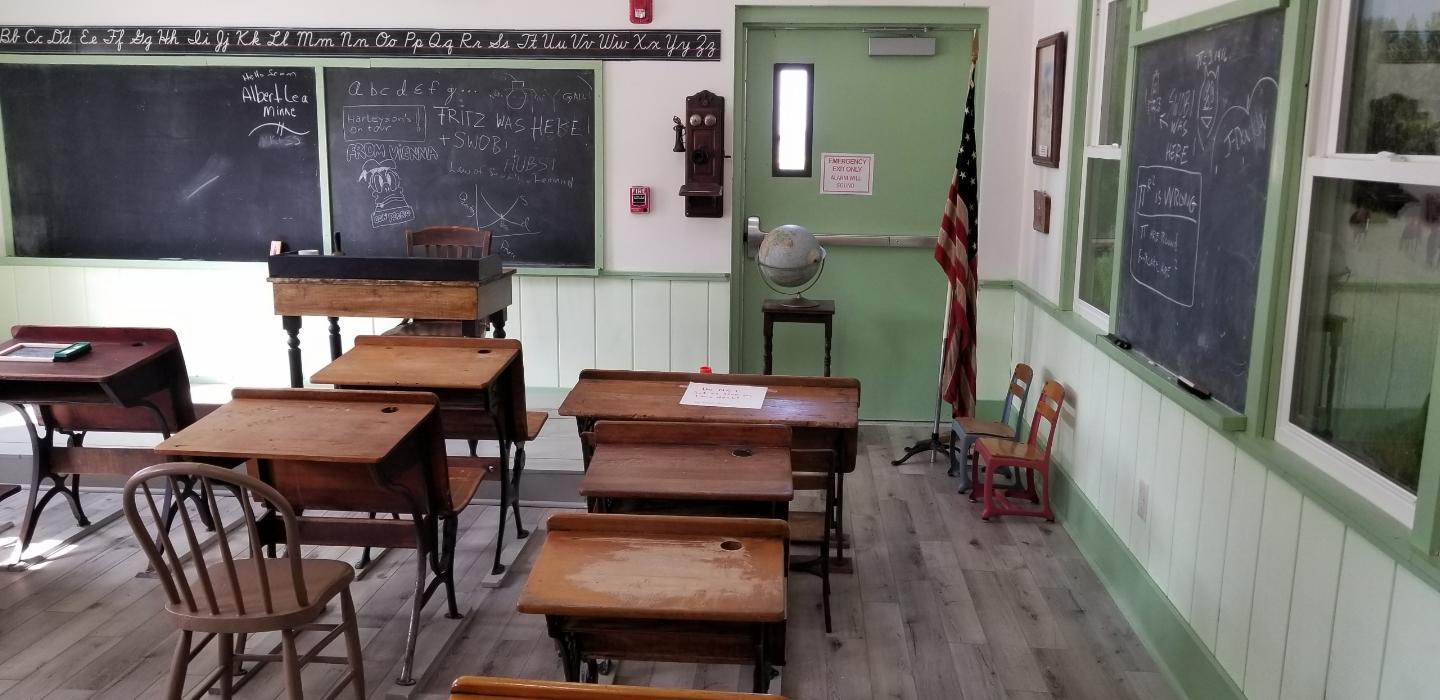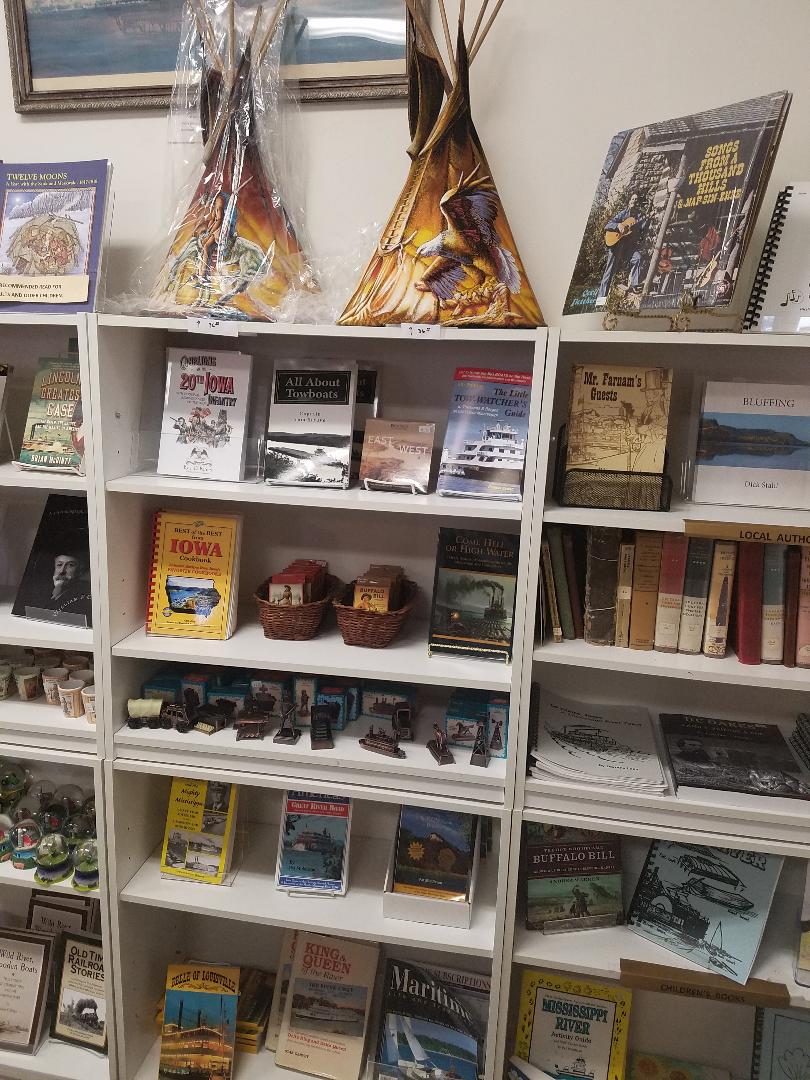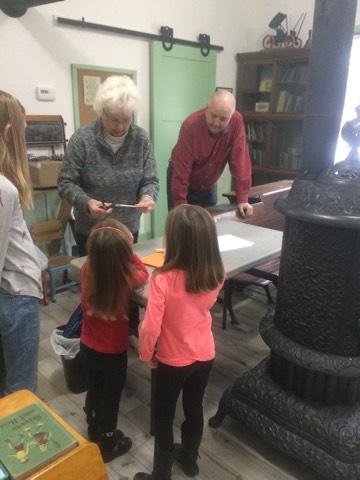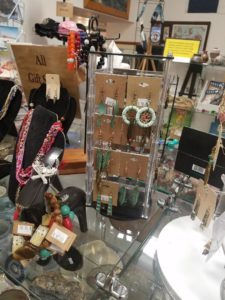WHAT’S NEW:
-
We have added audio narratives to a few of our exhibits: Native Americans, Homesteading and James Ryan.
The Robert Schiffke 1920’s Era One Room School House Exhibit in honor of the museum’s director. For a century, from the 1850’s to the 1950’s, one room school houses in Iowa were thriving. The peak years for one room schools occurred during the 1910’s and 20’s. With many of the one room schools in Iowa closing in the mid to late 1950’s. The museum’s project is focused on what students would have experienced in the 1920’s. The replica contains authentic artifacts used in one room school houses located in Iowa. The exhibit encourages visitors to interact with objects found in daily educational techniques of that time. The display is a wonderful educational tool for the museum that gives visitors an inside look of how one room school houses and education throughout the years has changed and evolved. The Buffalo Bill Museum is pleased to be able to bring such a fine educational tool the region.
More Exhibits:
- LeClaire’s Historical District
- Buffalo
- 1920’s one room school house exhibit
- A few years ago, we received a donation from Mike Wolfe of “American Pickers“. It is Iron-Eyes Cody’s Tee Pee. He was an Italian actor who portrayed an Indian in many Westerns, including John Wayne. He also was known as the crying Indian from the TV commercial to save the environment. The show also did a good tribute to Cecil Fletcher who was friends with the actor and we have a display dedicated to him as well. Cecil was a local musician who wrote a song about LeClaire and had it copyrighted so we have an official city song. Not too many towns can boost that. We also sell his music.
- Room opened just for “Kids”. Children ages 3 to 8 years old accompanied by an adult can find “hands-on” exhibits they can explore. We have a pilots’ wheel, a musical wall, dress up area, a place to plant a garden, and much more fun.
Remember all children can do a “find and seek” hunt in the museum and receive a free prize.
- A room has opened for the Ladies to enjoy looking at fashions women wore in the early 1900’s. Come and view these clothes to see if you think they will ever come back in fashion.
- River Pilots’ peer newest exhibit features “clams” and more “clams”. See how they were harvested from the Mississippi River and how they were used to make buttons.
- 1939 Chris Craft Speed Boat on Display
- A 3 foot hand crafted replica of the riverboat the Robert E. Lee
 “Philip Suiter, Legendary Riverboat Pilot” in the River Pilots’ Pier area of the museum. Philip’s descendants have sponsored the display that features Philip Suiter, the first riverboat pilot in LeClaire. DETAILS and photos of the Exhibit
“Philip Suiter, Legendary Riverboat Pilot” in the River Pilots’ Pier area of the museum. Philip’s descendants have sponsored the display that features Philip Suiter, the first riverboat pilot in LeClaire. DETAILS and photos of the Exhibit
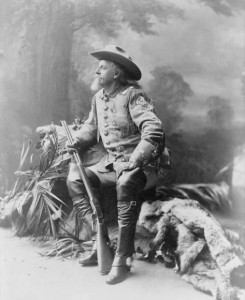 William F Cody “Buffalo Bill” (1846 – 1917) was born in LeClaire, IA. His career as a frontiersman, US Army Scout, and later as a showman touring throughout the United States and Europe with his “Wild West Congress” show, has made him a favorite figure among the many generations of visitors to the museum.
William F Cody “Buffalo Bill” (1846 – 1917) was born in LeClaire, IA. His career as a frontiersman, US Army Scout, and later as a showman touring throughout the United States and Europe with his “Wild West Congress” show, has made him a favorite figure among the many generations of visitors to the museum.
Professor James J. Ryan II, “Crash Ryan” (1903-1953) was a 1920 graduate of the LeClaire High School, later attending Iowa State University, and teaching at the University of Minnesota. As a professor, he tested automobile safety equipment ranging from a hydraulic bumper to seat belt designs (thus the n ickname “Crash Ryan”). He is most famous as the inventor of the Ryan Flight Recorder in 1972, or the “Black Box” of which there is one displayed in the museum.
ickname “Crash Ryan”). He is most famous as the inventor of the Ryan Flight Recorder in 1972, or the “Black Box” of which there is one displayed in the museum.
 James B. Eads (1820 – 1887) was a self-taught engineer who included LeClaire, Iowa as one of his hometowns over the course of his lifetime. His gunboat designs include the Civil War’s “Iron Bells” which were the precursor of today’s modern submarines. However, he is best known for the Eads Bridge which spans the Mississippi River at St. Louis. His design was employed steel which was an unproven component in bridge design.
James B. Eads (1820 – 1887) was a self-taught engineer who included LeClaire, Iowa as one of his hometowns over the course of his lifetime. His gunboat designs include the Civil War’s “Iron Bells” which were the precursor of today’s modern submarines. However, he is best known for the Eads Bridge which spans the Mississippi River at St. Louis. His design was employed steel which was an unproven component in bridge design.
 Cecil Fletcher (1918-2002 ) was a local musician and “favorite son,” having composed the “LeClaire Song,” the official song of the community in which the Buffalo Bill Museum is located. Along with a love of music, he was well-known for the miniature replicas of an old school house, church, and other buildings built to encourage the community to share his desire to preserve local history. The museum features a video performance of the “LeClaire Song” and has a number of his instruments on display.
Cecil Fletcher (1918-2002 ) was a local musician and “favorite son,” having composed the “LeClaire Song,” the official song of the community in which the Buffalo Bill Museum is located. Along with a love of music, he was well-known for the miniature replicas of an old school house, church, and other buildings built to encourage the community to share his desire to preserve local history. The museum features a video performance of the “LeClaire Song” and has a number of his instruments on display.
 Red Cross Quilt (1919) was a fundraiser to support the wounded soldiers of WWI. A 10-cent donation would allow volunteers to place your name on an embroidered patch on the quilt and be one of 834 people who contributed to the fundraiser. Other quilts are also on display in the museum, and details about construction is provided.
Red Cross Quilt (1919) was a fundraiser to support the wounded soldiers of WWI. A 10-cent donation would allow volunteers to place your name on an embroidered patch on the quilt and be one of 834 people who contributed to the fundraiser. Other quilts are also on display in the museum, and details about construction is provided.
 The “Green Tree Hotel,” the largest Rock Elm on record, was located at the start of the “Rock Island Rapids” at LeClaire, Iowa. It was a gathering place and campsite for river pilots and men seeking work on the river boats.
The “Green Tree Hotel,” the largest Rock Elm on record, was located at the start of the “Rock Island Rapids” at LeClaire, Iowa. It was a gathering place and campsite for river pilots and men seeking work on the river boats.
In 1912 it was entered in the “Hall of Fame for Trees” (when it was approx. 175 years old) because of its unique role in local history; in 1964 it succumbed to Dutch Elm Disease. A museum exhibit includes a cross section of this large elm, including its unusual hollow core.
 The Lone Star Stern Wheeler (built 1869, retired in 1889. In 1890 a new Lone Star was built and decommissioned 1967) is the only surviving example in the United States of a wooden-hulled boat built in the traditional Western Rivers fashion. That river system, comprised of the Mississippi, Ohio, and Missouri Rivers carried most of the immigrants and freight that settled the Midwest. The Lone Star was designated a National Historic Landmark and is open to visitors at the Buffalo Bill Museum. The boat’s enclosure, The River Pilot’s Pier, has won a significant design award from the State of Iowa for its “green” design in 2008. NEW! The museum has added an exciting new reason for you to visit the Lone Star Steamer. A new sound system has been added to the River Pilot’s Pier building where the Lone Star is located. The new sound system allows you to experience the sounds of the steamer traveling on the river along with background sounds.
The Lone Star Stern Wheeler (built 1869, retired in 1889. In 1890 a new Lone Star was built and decommissioned 1967) is the only surviving example in the United States of a wooden-hulled boat built in the traditional Western Rivers fashion. That river system, comprised of the Mississippi, Ohio, and Missouri Rivers carried most of the immigrants and freight that settled the Midwest. The Lone Star was designated a National Historic Landmark and is open to visitors at the Buffalo Bill Museum. The boat’s enclosure, The River Pilot’s Pier, has won a significant design award from the State of Iowa for its “green” design in 2008. NEW! The museum has added an exciting new reason for you to visit the Lone Star Steamer. A new sound system has been added to the River Pilot’s Pier building where the Lone Star is located. The new sound system allows you to experience the sounds of the steamer traveling on the river along with background sounds.
 Other exhibits at the museum focus on Mississippi River history; artifacts and records of LeClaire families such as household items, clothing and personal effects; recreation of a one-room schoolhouse accompanied by records from the school serving the region’s families; manufacturing exhibits; Indian and prehistoric artifacts.
Other exhibits at the museum focus on Mississippi River history; artifacts and records of LeClaire families such as household items, clothing and personal effects; recreation of a one-room schoolhouse accompanied by records from the school serving the region’s families; manufacturing exhibits; Indian and prehistoric artifacts.

